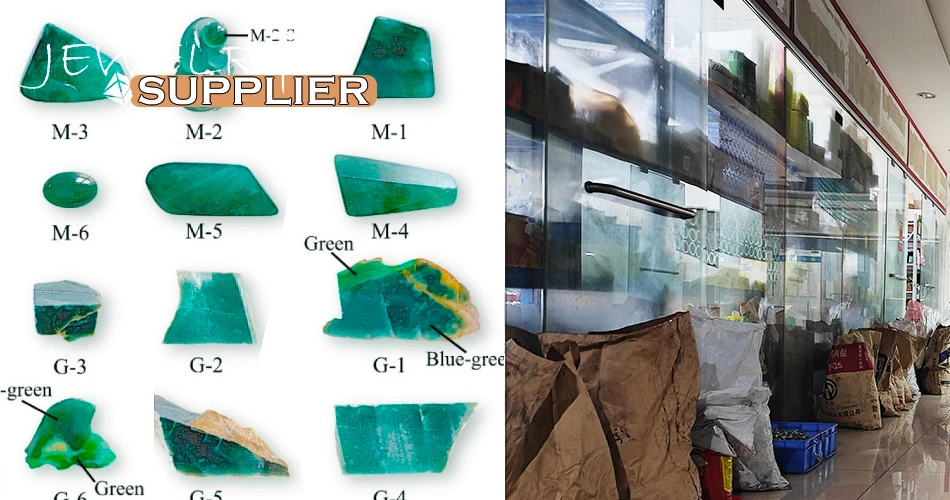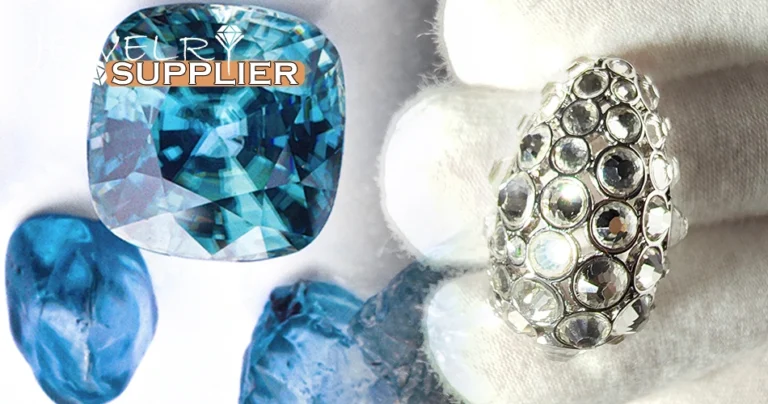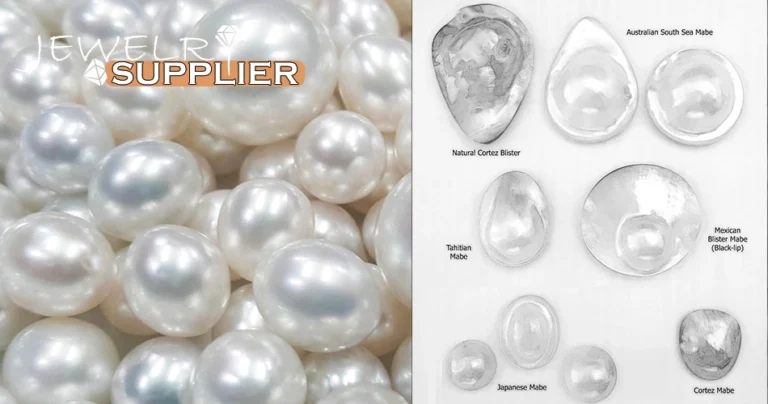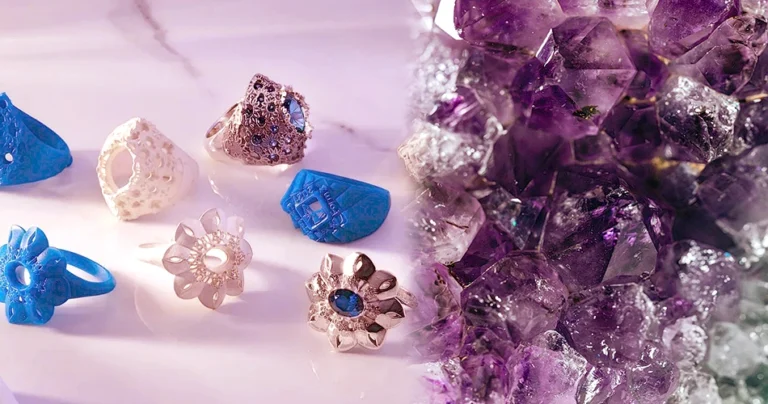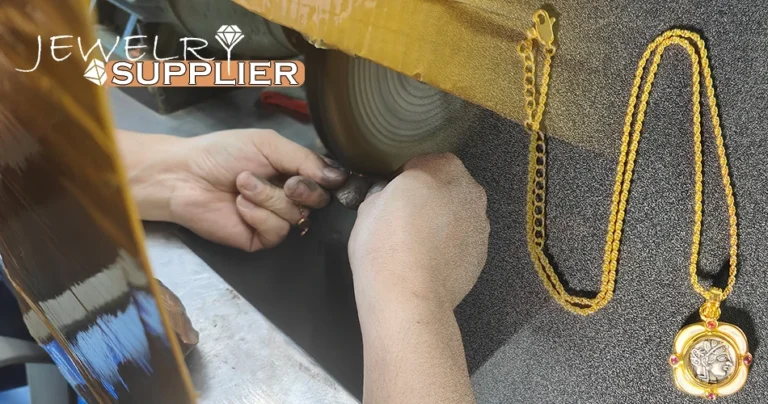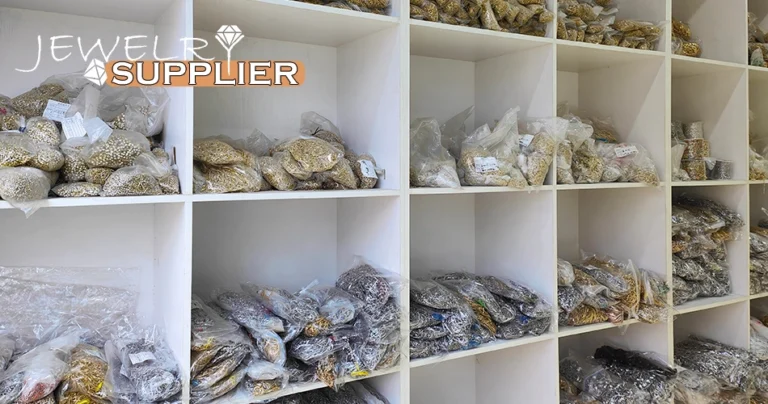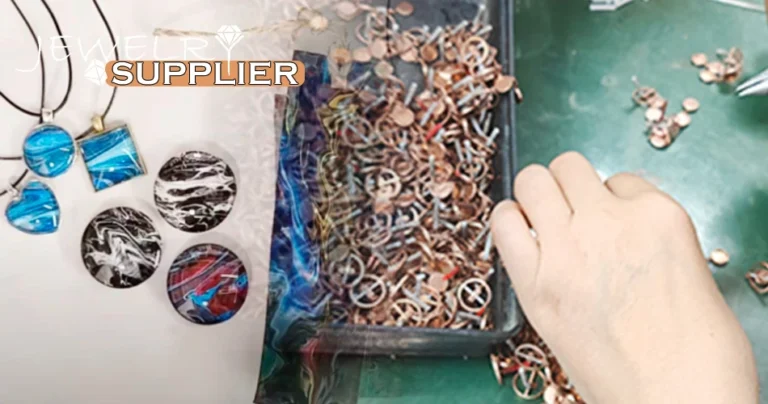Processing Techniques for Jade Jewelry
The combination of natural materials and processing techniques creates a stunning transformation from raw stone to artwork. The exquisite craftsmanship that gives jade jewelry its charm is truly unique. The process begins with material selection, where artisans assess the jade’s internal quality and external features to determine the most suitable design direction. Artisans conceptualize and design based on the characteristics of the jade, establishing the final piece’s theme and style. This requires artisans to have extensive experience and keen insight to ensure that each piece of jade is presented in the most appropriate way.
Using traditional tools like hammers and chisels, artisans perform initial carving according to design sketches, shaping the basic form and outline. They carefully control the jade’s texture and hardness to ensure that the carving lines are smooth and distinct. Every strike and carve demands the artisan’s full concentration to perfectly capture every detail from the design. Building on the initial carving, through meticulous sculpting and refinement, the jade gradually reveals its unique textures and luster, with every line coming to life as if the jade itself has been given life. Finally, polishing adds the finishing touch to the jade jewelry. Polishing not only enhances the surface shine but also makes the jade’s colors more vibrant and its texture more refined. Under the skilled hands of jewelry craftsmen, the jade surface gradually achieves a mirror-like sheen, perfectly showcasing every detail.
Drilling is a crucial step in jade jewelry production, testing the artisan’s skills and directly affecting the beauty and practicality of the final product. Through precise drilling, artisans ensure that each piece of jewelry displays its intended brilliance and vitality. Whether it’s jade necklaces, bracelets, or earrings, every hole is meticulously calculated and processed to ensure both aesthetic appeal and functionality. The production of jade jewelry involves not only drilling and carving but also an important post-processing step: waxing. The waxing process provides an additional protective layer for the jewelry while enhancing its aesthetic appeal.
Material Selection and Quality Assessment for Jade Jewelry
Unlike traditional processing, jewelry supplier‘s jade jewelry production begins with selecting suitable materials before design can take place. The choice of jade directly impacts quality and aesthetics. Different varieties of jade possess distinct textures, colors, and luster, making material selection a vital step. High-quality jadeite and Hetian jade are often small, multi-cracked, and multi-colored, usually at a high price point. In contrast, lower-grade jade types, like xiu jade, tend to be larger, less cracked, and of a single color, and are relatively inexpensive. When selecting high-quality jade materials, careful observation of the surface for cracks and flaws is essential; if few exist, color, size, and shape can guide the choice—square pieces are suitable for vessels, triangular for birds, and elongated for human figures. Material selection is critical and requires an experienced jade sculptor with a discerning eye to recognize the essence of the jade and make precise selections that enhance the final piece.
Evaluating jade involves assessing its type, color, texture, and transparency. Initial evaluations include checking for surface cracks, impurities, or other defects. Experienced artisans predict the finished effect based on the jade’s characteristics. Good jade should have a fine texture and a warm, smooth feel. Uniformly colored and vibrant jade is highly sought after. For certain types of jade, like jadeite, higher transparency is seen as a mark of quality. It’s advisable to choose jade that is whole and crack-free to ensure durability and beauty in the finished product. The final selection should also take customer preferences into account, considering the intended use of the finished piece.
Selection of Jadeite Materials:
Dragon Stone: Extremely fine texture with almost no impurities; internal structure is difficult to see, giving a delicate and soft feel.
For more common materials, please click here to learn.
Glass Type: Very fine texture with high transparency, almost flawless, one of the top grades of jadeite.
Ice Type: Fine texture and high transparency, slightly lower than glass type, with an appearance similar to ice.
Sticky Type: Fine texture with lower transparency, resembling rice porridge, hence the name.
Bean Type: Coarser texture with a noticeable grain, lower transparency, and relatively inexpensive.
Oil Green Type: Darker color with gray tones, surface luster resembling oil.
Egg White Type: Fine texture with average transparency, resembling egg whites, and relatively pure.
Color Classification:
Green Types: Includes light green, yellowish green, sprout green, apple green, spinach green, gold thread green, and deep green—these are the most popular colors in jadeite.
Yellow Jade: Yellow or orange-yellow jade with vibrant color.
Red Jade: Most red jades are artificially treated (such as heat-treated) to achieve red coloration.
Blue Flower/Blue Water: Jade with blue tones, sometimes accompanied by white or gray inclusions.
Clear Water: High transparency jade with light blue or green hues, like the water of a clear sky.
White Jade: Color ranges from nearly colorless to milky white, even with a hint of gray. Purity of color is a key factor in assessing quality.
Black Jade: Deep, rich black color with a mysterious charm, showing a steady sheen and depth.
Multicolor: Refers to jade that features two or more colors within a single piece, either naturally occurring or treated.
Selection of White Jade Materials:
Hetian White Jade: Originating from the Hetian region in Xinjiang, it has a fine texture and warm color, pure white like snow, suitable for various ornaments, conveying a sense of nobility and elegance.
Sheep Fat White Jade: A type of Hetian white jade, named for its color and texture resembling sheep fat, appearing pure white and semi-transparent with a faint pink mist, warm to the touch, and highly sought after by collectors.
Snow White Jade: Evenly colored with small crystalline grains distributed like snowflakes on the surface, the finer the grains, the better the quality. Its pure white color conveys freshness and natural beauty.
White Chalcedony: Primarily white, with a fine texture, good oiliness, soft luster, and some transparency, commonly found and more affordable than Hetian jade.
Jing White Jade: Fine texture and oily luster, pure white color, suitable for various ornaments.
Honey Wax: A fossilized tree resin available in various colors, with yellow honey wax being the most common, uniquely paired with white jade beads.
Afghan Jade: Pure white and fine texture, gaining popularity in recent years for various ornaments, especially carved pieces.
Selection of Amber Materials:
Transparent Amber: High transparency with a variety of colors ranging from light yellow to deep brown.
Honey Wax: Opaque or semi-transparent, warm colors typically from yellow to brownish-yellow.
Insect Amber: Contains insects or plant fragments within.
Golden Amber: Exhibits golden or deep gold colors with high transparency.
Blood Amber: Deep red in color with high transparency.
Flower Amber: Contains bubbles or impurities that create unique patterns or designs.
Blue Amber: Appears blue or bluish-green from certain angles with high transparency.
Green Tea Amber: Green in color with high transparency.
White Amber: White or creamy color with lower transparency.
Green Amber: Green in color with high transparency.
Black Amber: Ranges from dark brown to black with lower transparency.
Golden Swirled Amber: Transparency between transparent amber and honey wax, golden in color with bubbles or impurities.
Selection of Turquoise Materials:
Iron Line Turquoise: Features unique back patterns resembling spider webs or branches, formed by iron mineral deposits within the stone. Best suited for pendants, earrings, and rings.
Porcelain Turquoise: Hard texture with bright colors, usually sky blue or deep blue, smooth surface and high luster. Ideal for various jewelry pieces like bracelets, necklaces, and rings.
Green Turquoise: Softer than porcelain turquoise, green in color and not suitable for heavy impact.
Dotted Turquoise: Characterized by white or yellow specks on the surface resembling raindrops; suitable for personalized jewelry like pendants and brooches.
Spider Web Turquoise: Features dense iron line patterns resembling spider webs, ideal for large pendants or as a centerpiece for rings.
Water Grass Turquoise: Contains internal patterns resembling water grass, typically formed from iron or copper lines. Suitable for pendants and brooches that showcase its inner structure.
Blue Turquoise: Typically blue in color with a fine texture.
Selection of Quartz Materials:
White Quartz: Clear and transparent, believed to enhance intelligence and memory.
Amethyst: Charming purple color, symbolizing wisdom and spirituality.
Rose Quartz: Gentle pink hue, believed to promote relationships and love.
Golden Rutilated Quartz: Transparent with golden needle-like inclusions, believed to attract wealth.
Smoky Quartz: Brown or tea-colored, believed to stabilize emotions and protect the wearer.
Citrine: Bright yellow, believed to attract wealth and boost confidence.
Obsidian: Deep black, believed to repel negative energy and protect the wearer.
Strawberry Quartz: Transparent with red dots or flakes, believed to enhance social skills and attract romance.
Green Phantom Quartz: Transparent with green inclusions, believed to attract wealth and enhance creativity.
Tourmaline: Comes in various colors, including pink, blue, and green, believed to enhance energy and purify the environment.
Fluorite: Available in multiple colors, believed to relieve stress and promote clear thinking.
Rainbow Spectrum Quartz: Transparent with various colors, believed to balance mind and body.
Aquamarine: Light blue, believed to calm the mind and facilitate communication.
Tiger’s Eye: Gold or reddish-brown with a unique cat’s eye effect, believed to enhance personal charm and courage.
Jade Jewelry’s Material Preparation and Design
Jewelry wholesaler‘s Jade pieces are not fixed in form, as each naturally formed piece varies. The design of jade jewelry must reflect the characteristics of the chosen jade material to achieve comfort, fluidity, and popularity. This requires leveraging the unique attributes of the raw material while combining aesthetic form to highlight the jade’s distinct features, such as texture, luster, color, and transparency. The beauty of the texture showcases jade’s warm qualities. Based on jade’s size, shape, and color, decisions must be made about cutting to maximize its value. Designers and artisans must create design schemes that align with the jade’s natural characteristics while meeting market demands, minimizing the impact of cracks and impurities during the design process.
Material Removal: The raw stone’s exterior may have a covering layer that needs to be removed to better understand the internal condition. If necessary, the raw stone may be cut to inspect internal structure and quality. Just like selecting jade, close observation of the surface is essential; if the jade is of good quality, with few cracks and flaws, selections can be made based on color, size, and shape.
Carving Techniques for Jade Jewelry
Rough Grinding Process: This step removes impurities and excess material from the jade surface, laying the groundwork for subsequent fine grinding and polishing. Rough grinding uses a grinding wheel with coarse abrasives to gradually eliminate surface irregularities. For finer details, sandpaper may be employed for manual sanding. It’s important to maintain adequate moisture during this process to minimize dust and heat generation. Control the pressure carefully to avoid over-grinding, which can damage the jade.
Carving Process: Carving specific patterns or shapes into the jade bestows it with artistic value. Common tools include chisels, drill bits, and engraving machines. Detailed planning and design are essential before carving to ensure the patterns align with the overall design. Careful attention must be paid to the depth and angle of carving to maintain clarity and prevent wear. Avoid causing unnecessary damage to the jade during this process. Each step of carving requires the artisan’s meticulous operation and skill to ensure the beauty and durability of the final product. Additionally, the design and processing of jade jewelry should consider the practicality and artistic value of the finished piece, ensuring that each creation is a unique work of art.
Hand Carving: Using chisels, artisans carve manually according to design plans or personal creativity.
Mechanical Carving: This involves using machines like engraving machines to carve based on pre-set programs.
Carving Techniques:
Intaglio (Sunken Carving): Creating recessed lines or patterns on the jade surface.
Relief Carving: Creating raised lines or patterns on the jade surface.
Bas Relief: Carving strong three-dimensional patterns, which can be shallow or deep relief.
Round Sculpture: Crafting three-dimensional forms.
Fine Grinding and Polishing Techniques for Jade Jewelry
Fine grinding further refines the jade surface established during rough grinding, ensuring a good foundation for polishing. This process is crucial for enhancing the surface smoothness and detail of jade jewelry. Each step of fine grinding requires careful craftsmanship and technique to ensure the aesthetic and durability of the final product. The fine grinding process not only tests the artisan’s skills but also reflects a deep understanding of the jade material and artistic expression. By following these fine grinding steps, the surface of jade jewelry can achieve the desired smoothness and polish, setting a solid foundation for the polishing process. The subsequent polishing steps ensure the surface achieves ideal luster, showcasing the best visual effect. This series of polishing processes allows jade jewelry to present a warm, radiant beauty, becoming cherished treasures. Polishing not only enhances the jade’s external beauty but also imparts unique artistic value.
Fine Grinding Process:
Before fine grinding, the jade surface must be thoroughly cleaned to remove dust and impurities from the rough grinding process.
Using Sandpaper: Secure the jade to a workbench and sand with sandpaper. Gradually increase the fineness of the sandpaper until the jade surface is very smooth.
Using Grinding Wheels: Similarly, switch to finer grinding wheels until the surface achieves the desired smoothness. After fine grinding, the surface should be wiped clean to remove any powder and residue, and oils may be applied to enhance the sanding effect.
Polish Inspection: After fine grinding, inspect the surface to ensure the desired finish is achieved.
Sculpting: One of the processes in jade carving refers specifically to the making of jade artifacts, known as “sculpting” in trade terms. Due to jade’s exceptional hardness, iron discs—called “tongs”—are used as tools, with water and diamond powder as mediums, employing techniques such as cutting, chiseling, pressing, and smoothing to meticulously carve jade piece by piece. This process differs significantly from traditional carving. Jade sculpting is a precise skill, with expert artisans achieving artistic effects that convey both depth and delicacy.
Polishing: Another process in jade crafting, also known as “brightening” or “polishing,” involves smoothing rough areas of jade using materials like lacquers, wood, gourd, leather, and copper tools. Chemicals such as chromium oxide can be used as mediums to reveal the jade’s inherent smoothness, warmth, and luster.
Double Hook Grinding Method: A renowned jade carving technique from the Han dynasty. Historical records describe its engraved patterns as delicate and flowing, resembling fine threads of hair. Evidence from exquisite Han jade artifacts supports these claims.
Two-Layer Technique: Emerging in the mid-Qing dynasty, this technique is commonly found in architecture like the Forbidden City and Suzhou gardens. It involves carving two distinct patterns on either side of a flat (or slightly convex) jade piece, creating a hollow section in between that connects around the edges. The patterns are intricately interwoven, presenting a unique and challenging craftsmanship.
Gold Inlaid Jade: Using traditional gold inlay techniques, fine line patterns are created on jade artifacts, then inlaid with gold or silver wires. The jade must undergo polishing. Commonly referred to as “gold inlay,” it reflects the meticulous nature of ancient Chinese crafts.
Softening Jade Method: This method softens jade for easier carving. Due to jade’s hardness, several water-soaked tubers can be used to soak the jade overnight, followed by applying specific agents to the carved areas until fully treated.
Polishing Process:
The polishing process for jade jewelry is a vital step that directly influences the final product’s luster and tactile feel. Prior to polishing, the jade jewelry must undergo meticulous carving and finishing to ensure every detail is flawless. Artisans carefully inspect every corner of the jade to ensure no minute imperfections are overlooked. The selection of suitable polishing tools and materials, including various grits of sandpaper, polishing powders, and polishing discs, is also crucial.
Rough Polishing: This foundational step involves using coarser sandpaper or wheels to remove carving marks and surface irregularities. It requires a blend of patience and strength, ensuring that the jade’s shape and details are preserved while eliminating roughness.
Fine Polishing: Following rough polishing, the jade surface begins to shine. Artisans then use finer sandpaper or polishing powder for this step, requiring even greater care to ensure every inch of the jade is polished properly.
Precision Polishing: This critical step determines the final luster and transparency of the jade. Using extremely fine polishing powders and soft discs, artisans achieve a mirror-like shine through repeated friction.
Drilling Process for Jade Jewelry
The drilling process is essential for jade jewelry that requires stringing or setting metal, such as necklaces, bracelets, and earrings. The accuracy and efficiency of the drilling technique directly affect the jewelry’s aesthetic appeal and durability. The choice of drilling tools depends on the jade’s hardness and the size of the holes needed, with different types available for various jade jewelry.
Drilling Tools:
Diamond Drill Bits: Suitable for harder jade, like jadeite. These bits have exceptional hardness for efficient drilling in tough materials.
Ultrasonic Drill Bits: Ideal for softer jade, using high-frequency vibrations for quick drilling while minimizing material wear.
Laser Drill Bits: Perfect for intricate designs and precise holes, laser drilling technology cuts exact hole shapes in jade with minimal wear or thermal damage.
Manual Drilling: For smaller holes, artisans may opt for manual drilling. Using diamond drill bits attached to power tools, they slowly and steadily drill along pre-marked positions. This process demands high concentration and control to prevent slipping or damaging the jade.
Mechanical Drilling: For larger holes or mass production, mechanical drilling is typically used. Specialized machines allow for quick and precise drilling in jade, with adjustable speeds and feed rates to suit different jade hardness and thickness.
Ultrasonic Drilling: An efficient technique using high-frequency vibrating drill bits to create holes in softer jade quickly while minimizing wear.
Laser Drilling: A high-precision method ideal for complex designs and fine holes, with lasers cutting exact shapes with little to no wear or thermal damage.
Post-Processing of Holes: After drilling, any burrs or uneven edges must be cleaned up, often requiring fine sandpaper or special tools for smoothing the hole edges.
Types of Drilled Holes:
Jade Necklaces: A circular hole is drilled at the pendant position to attach it to a metal chain. It’s essential to ensure the hole is centered and appropriately sized for threading.
Jade Bracelets: Jade beads are strung into a bracelet, with small holes drilled for elastic thread. The hole size should be sufficient for the thread to pass through without being too tight or too loose.
Jade Earrings: Two small holes are drilled at the top of jade beads to attach them to metal ear posts. Care must be taken with these holes to ensure they are small yet secure to prevent falling.
Jade Rings: A small hole is drilled at the top of jade rings for securing them to metal settings. Precision in the hole’s size and position is crucial for proper mounting.
Wax Sealing Process for Jade Jewelry
The wax sealing process is an essential step in jade jewelry creation, protecting the jade from external environmental factors and significantly enhancing its appearance. Wax sealing effectively prevents the expansion of tiny surface cracks and shields the jade from potential damage due to temperature fluctuations. Additionally, wax enhances the jade’s color and luster, making it more vibrant and attractive.
Steps in the Wax Sealing Process:
Cleaning and Preparation: Before sealing, ensure the jade jewelry has undergone all carving and polishing processes, with a clean, dust-free surface. Thorough cleaning is necessary to remove stains and polishing residues.
Choosing the Right Wax: Select appropriate wax based on the jade type and desired luster. Common options include paraffin, beeswax, or specialized jade maintenance wax.
Heating the Wax: Place the wax in a designated heating device to melt it into a liquid state. Various wax types, such as natural beeswax or synthetic wax, can be chosen depending on specific needs and jade characteristics.
Applying the Wax: Using a brush or cotton swab, evenly coat the melted wax onto the jade jewelry’s surface. The thickness of the wax should be moderate; too thick can alter the jade’s natural color, while too thin won’t provide adequate protection.
Curing the Wax: After applying, let the jade jewelry cool at room temperature to allow the wax to solidify. Curing time may vary depending on the wax type and thickness.
Removing Excess Wax: Once the wax layer has set, gently wipe the jade surface with a soft cloth or cotton swab to remove any excess wax, especially from carved details and hard-to-reach areas.

